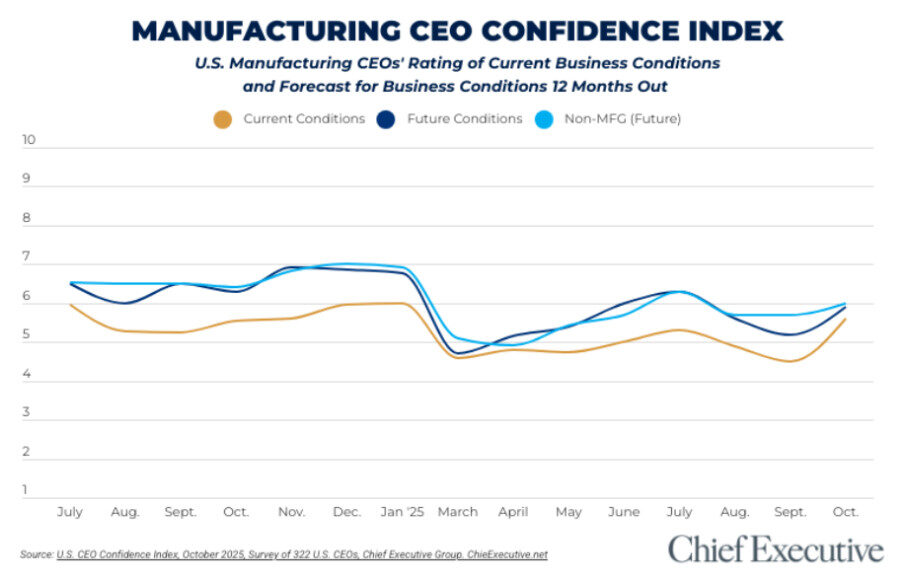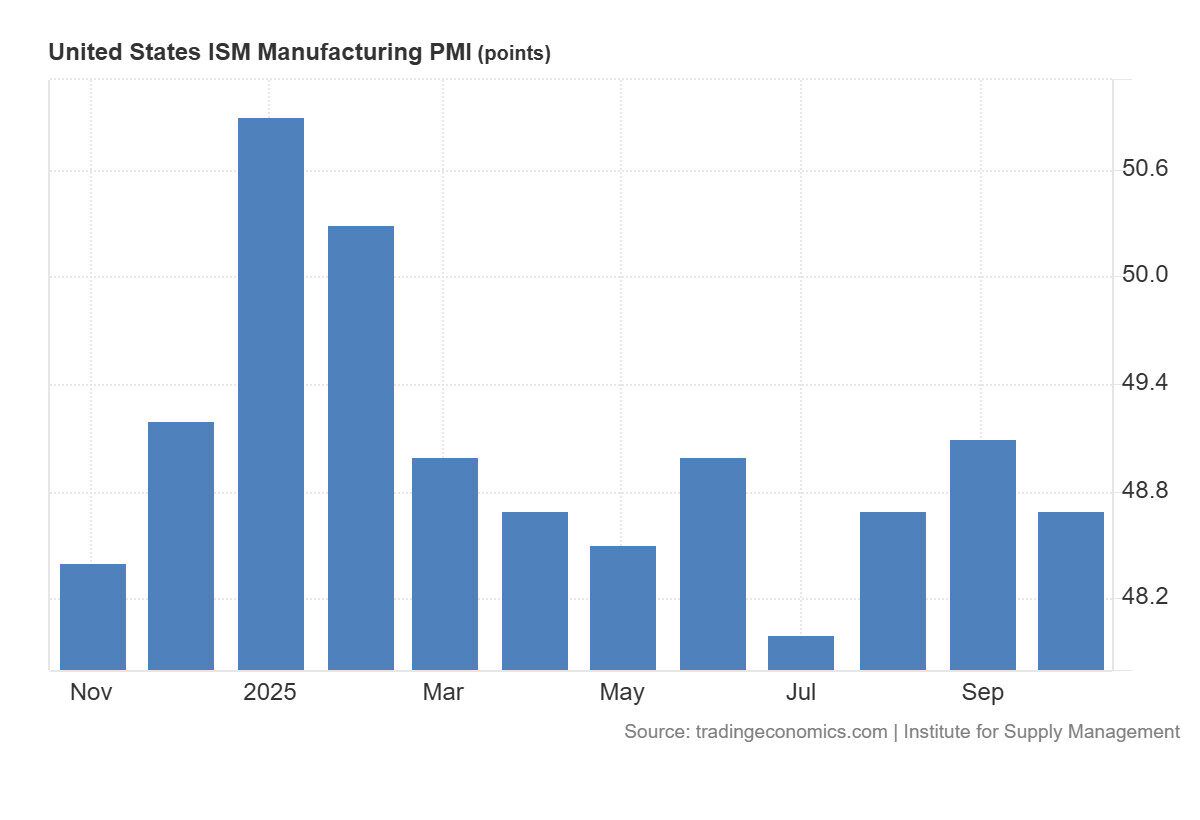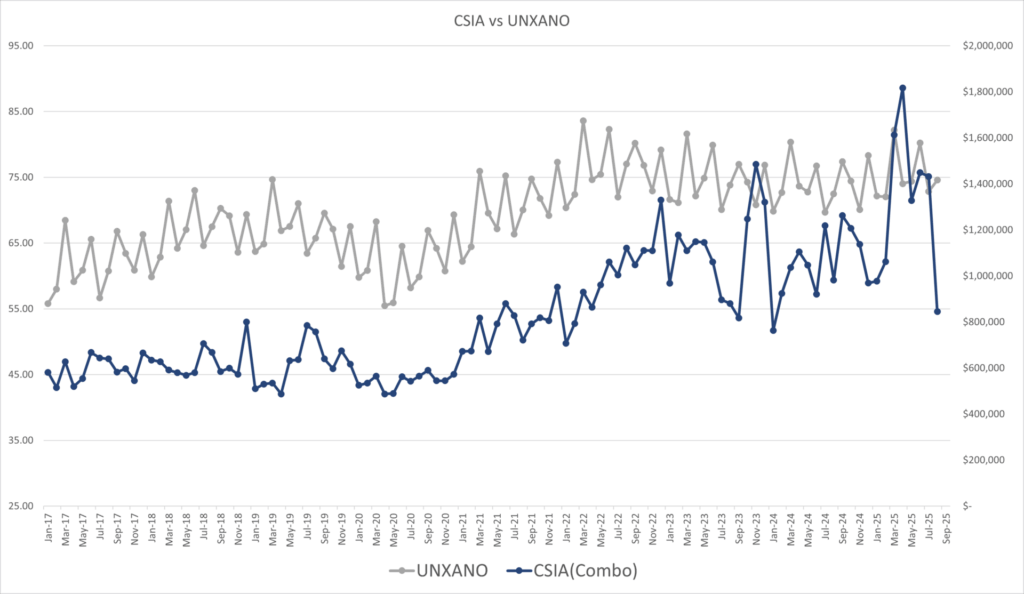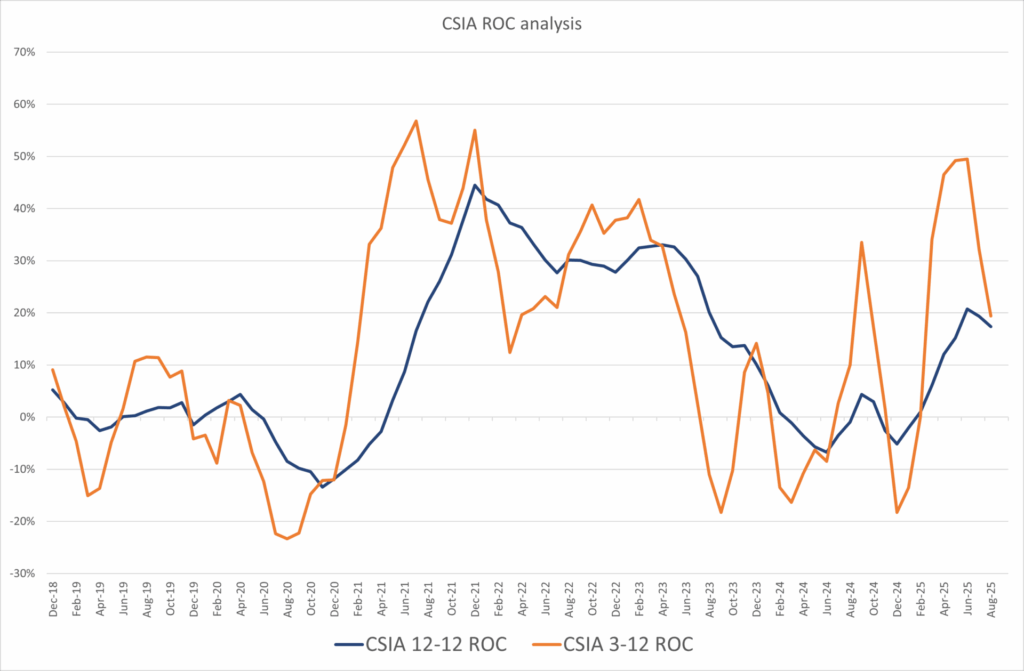Economic Insights
This collection of the latest updates and data from the systems integration industry explores leading indicators including the CEO Confidence Index, Purchasing Managers Index, and CSIA updates. We offer our own insights based on the information referenced and interactions with Exotek clients and the SI community.
Manufacturing CEO Confidence Rebounds After Months of Decline
After a summer of softening sentiment, U.S. manufacturing CEOs are reporting a renewed sense of optimism, citing strong backlogs and early signs of capital projects being released.
- CEOs rated current conditions at 5.6 / 10, up from 4.5 the prior month — the first increase since spring.
- 62% expect revenues to grow in the year ahead (+3 pts).
- 53% expect profits to rise (+4 pts).
- 39% plan to increase capital deployment (+3 pts).
Manufacturing Sector Economic Activity Contracts for the Eighth Consecutive Month
The Manufacturing PMI registered 48.7 in October, down from 49.1 in September, signaling continued contraction in overall manufacturing activity. This marks the eighth consecutive month of decline following a brief mid-year rebound.
- New Orders: Contracting (49.4, +0.5)
- Production: Contracting (48.2, –2.8)
- Employment: Contracting (46.0, +0.7)
- Supplier Deliveries: Slowing (54.2, +1.6)
- Inventories: Contracting (45.8, –1.9)
- Customers’ Inventories: Too low (47.1, –0.6)
- Prices: Increasing at a slower rate (58.0, –3.9)
- Exports and Imports: Both contracting
CEO – October
The October rebound is a welcome shift after several months of pessimism. Manufacturers are regaining the confidence to move forward—but they’ll do it selectively and pragmatically.
- Backlog strength = near-term opportunity. Many manufacturers report record order books stretching into 2026–27. This suggests that SIs can expect a steadier flow of retrofit, capacity-expansion, and modernization work, even if large greenfield projects remain limited.
- Capex thaw is beginning. A 3-point rise in capital deployment plans means some of the “wait-and-see” projects from earlier in the year are being re-evaluated. SIs should re-engage dormant prospects, positioning projects as incremental, high-ROI steps rather than full plant overhauls.
- Domestic projects are leading the recovery. Confidence among U.S.-only manufacturers is notably stronger than among global operators, who remain cautious about tariffs and trade friction. Integrators with strong domestic footprints can capitalize first.
- Cautious optimism shapes buying behavior. Manufacturers are still navigating uncertainty. Expect continued pressure on price, proof of value, and shorter project cycles. SIs that can demonstrate clear cost avoidance, flexibility, and speed to value will win.
Manufacturing leaders are signaling confidence without complacency. For integrators, this is a moment to lean in with low-risk, high-impact solutions—showing how automation and controls investments can protect margins and prepare for growth once the broader economy steadies.
PMI – October
The October PMI reinforces a picture of steady but shallow contraction across U.S. manufacturing. While not catastrophic, it suggests a market that remains cautious, cost-sensitive, and selective about capital projects — all factors that directly shape integrator demand.
- Short-term softness, long-term stability. Manufacturers are still operating below expansion levels, but the slow rate of contraction points to stabilization rather than collapse. For SIs, this means pipelines will likely stay modest but consistent — focused on maintenance, optimization, and compliance rather than expansion.
- Operational optimization is the play. With both new orders and production slipping, clients are prioritizing productivity improvements over capacity growth. Integrators should position around efficiency gains, process automation, and resource utilization — projects that pay for themselves quickly.
- Staffing and skills gaps persist. The employment index remains in contraction, signaling continued labor shortages and hiring restraint. That opens doors for integrators to provide outsourced engineering capacity or managed automation services.
- Supply and inventory pressure easing. Slower supplier deliveries and contracting inventories suggest the supply chain is normalizing. This can help integrators by shortening lead times on components and reducing project delays.
- Pricing pressure is easing but real. The Prices Index remains above 50, indicating input costs are still rising — just more slowly. Integrators should continue to emphasize cost control, modular design, and flexible implementation options to align with clients’ budget discipline.
Manufacturing demand remains muted, but underlying stability is returning. For SIs, this is a time to focus on resilience and value delivery — helping manufacturers do more with the systems they already have while preparing them for the next growth cycle.
Exotek Insights – CSIA vs UNXANO Analysis
We have transitioned from tracking US Capital Goods New Orders (USCGNO) to Non-Defense Capital Goods Excluding Aircraft (UNXANO). This shift better aligns with the focus of most system integrators and provides a clearer indication of actual capital spending.
Our Key Takeaways
ROC Analysis
The UNXANO has remained stagnant since spring 2023 after it began slowing in June 2021.
Observations:
- Capital spending is inching its way back to growth territory
- 3/12 staying above 12/12 is a positive indicator
The 12/12 rate of change for capital goods new orders is finally entering growth territory, signaling an encouraging development for system integrator (SI) companies. As capital spending begins to recover and show signs of expansion, it is reasonable to anticipate that new orders for automation projects will start to materialize. However, it is important to note that it may take several months for this increase in capital orders to translate into direct opportunities for SIs.
Another positive indicator is that the 3/12 line remains above the 12/12 line. This trend suggests that the current modest growth in capital spending is likely to persist and is not expected to reverse in the near term. Together, these signals point to a cautiously optimistic outlook for SIs as the market gradually moves toward renewed growth.
Observations
Continued Softness Across our SI Community
The latest CSIA EZ Stats survey show continued softness across our SI community. Revenues have stabilized at lower levels, capacity remains under-utilized, and optimism about future business conditions fell sharply after several months of recovery.
- Revenue: Holding steady after a mid-year decline. Average reported revenue remains well below summer levels, suggesting stabilization rather than recovery.
- Capacity: Remains weak. Only about one in five integrators report being fully utilized — a significant drop from earlier in the year — indicating ongoing slack across much of the community, even if conditions have stopped deteriorating.
- Outlook: Fell sharply in October, dropping from 73 to 56 after several months of steady improvement. The reversal suggests renewed caution among integrators, likely reflecting the continued softness in manufacturing demand and delayed project releases.
Our Key Takeaways
The October EZ Stats data adds color to what we’re seeing across the industry: a market that’s still subdued, with workloads soft, utilization low, and confidence slipping after a brief rebound.
- Competitive pressure may increase. As firms compete for limited new work, differentiation through value, responsiveness, and quality execution will matter more than price alone.
- Opportunity in client partnerships. Even amid soft demand, clients are still wrestling with labor shortages and efficiency challenges. Integrators that position as trusted capacity or modernization partners will be best placed when confidence rebounds.
The CSIA data reinforces a cautious outlook: the market has found a floor, but not yet a footing. For Exotek and its clients, the focus should remain on efficiency, discipline, and readiness to capitalize when manufacturing confidence turns the corner.












